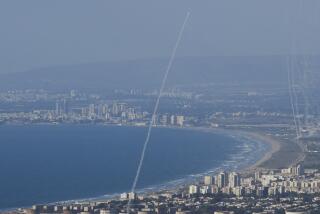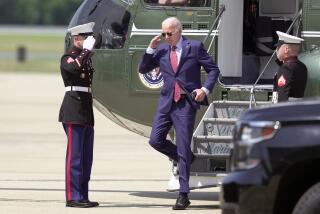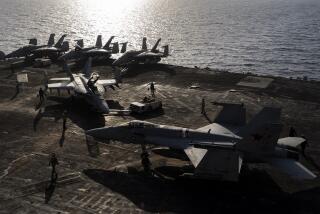Naval forcesâ humanitarian role to expand
SAN DIEGO â To combat global terrorism, Navy ships will deploy on more missions to bring medical help and construction teams to regions considered possible flash points for anti-American extremism, the vice chief of naval operations said here Wednesday.
Adm. Patrick M. Walsh, speaking to a civic group that supports the military, said that the recently completed maritime strategy plan for the Navy, Marine Corps and Coast Guard includes a ârenewed commitment to humanitarian missions.â
As examples of such missions, he pointed to the recent deployments of the hospital ship Comfort and the amphibious assault ship Peleliu outfitted as a hospital ship, as well as the upcoming deployment of the docking ship Fort McHenry.
Walshâs comments matched those by Adm. Gary Roughead, chief of naval operations, in a speech Wednesday to an international gathering at the Naval War College in Newport, R.I.
Roughead was backed by Marine Commandant Gen. James T. Conway and Adm. Thad Allen, commandant of the Coast Guard. âPreventing wars is as important as winning wars,â Conway said.
The San Diego and Newport speeches were meant as a rollout of a new strategy document that, in broad terms, outlines the sea servicesâ plans for the 21st century.
Much of the document deals with long-standing military concerns, including the requirement for a strong forward presence to act as a deterrent, a desire for stronger ties with allies, and the ongoing need to be able to move swiftly in case of conflict.
The humanitarian emphasis may signal the greatest change.
âWe can talk about what you destroy in war, but what is equally important is what you build in peace,â Walsh said.
In the past, the Navy has tended to cobble together its responses to humanitarian disasters -- such as the Indian Ocean tsunami in 2004 -- on an emergency basis. But naval planners now argue that in âthe battle of ideas,â humanitarian missions are a good method of counteracting suspicion of the U.S..
âIf we wait until a crisis to form relationships, we will be late to the game,â Walsh told the San Diego Fleet Week Foundationâs breakfast gathering. âTrust cannot be surged.â
The Navyâs post-tsunami relief effort centered around the San Diego-based hospital ship Mercy, but it is now experimenting with outfitting ships as âmedical platformsâ that are smaller and cheaper to operate than the massive hospital ships.
Medical personnel aboard the Baltimore-based Comfort saw 85,000 patients during stops off 12 nations of Latin America. The San Diego-based Peleliu, which is smaller than the Comfort, saw 31,000 patients in the Philippines, Vietnam, Bangladesh, Papua New Guinea, and the Solomon and Marshall islands. Both missions included Seabees who did construction projects.
The Fort McHenry, based in Little Creek, Va., is set for a seven-month deployment to nations in West Africa.
Adm. Robert F. Willard, the Hawaii-based commander of the U.S. Pacific Fleet, said that while it is too early to discuss specific ships and dates, there will be missions next year. âWe are committed to providing humanitarian assistance from the sea,â Willard said in an e-mail.
The new approach, summarized in a 16-page document called âA Cooperative Strategy for 21st Century Seapower,â could influence the types of ships the Navy purchases, as well as how it trains and conducts exercises. Humanitarian missions also involve host governments and nongovernmental relief agencies.
The plan also suggests that more Marines will be assigned to a âwider variety of ships and cutters for maritime security missionsâ such as boarding foreign ships and keeping sea lanes open, and that more Coast Guardsmen will be deployed far from the U.S.
The new strategy replaces the previous one written in the 1980s and is the first document crafted jointly by the three sea services.
--
More to Read
Get the L.A. Times Politics newsletter
Deeply reported insights into legislation, politics and policy from Sacramento, Washington and beyond. In your inbox three times per week.
You may occasionally receive promotional content from the Los Angeles Times.










